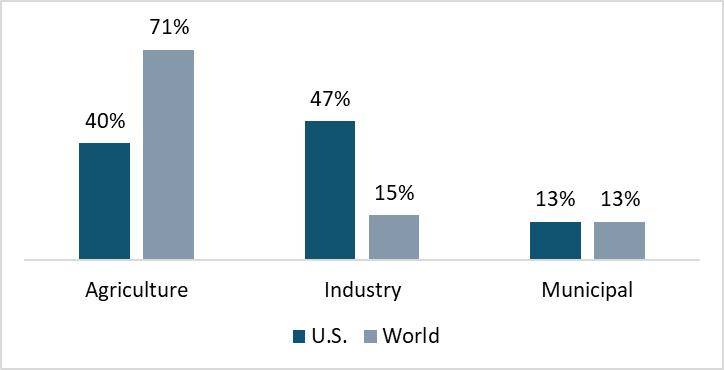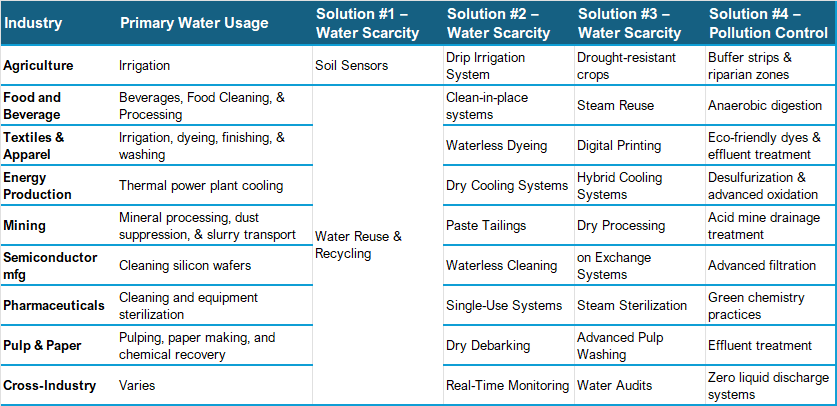At first glance, water seems plentiful on Earth since approximately 71% of our planet’s surface is covered with water. However, freshwater, essential for our survival, represents only 3% of the world’s water. Most freshwater exists in glaciers, polar ice caps, the atmosphere, and soil, leaving just 0.5% of Earth’s freshwater for human use. Due to climate change, concerns about water scarcity are growing because of the impact it will have on the environment, economy, and community. Factoring in pollution, which affects water quality and usability, these two issues are rising in importance for businesses as they navigate how to improve water sustainability.
Globally, agriculture accounts for roughly 72% of global freshwater withdrawals and industry accounts for approximately 20%, while in the US, industry accounts for most of freshwater withdrawals (47%), followed by agriculture (40%) and municipal use (13%). Of this freshwater withdrawal, about three-fourths comes from rivers, lakes and reservoirs and one-fourth comes from groundwater aquifers. Freshwater used for cooling electric power plants and irrigation accounts for 80% of domestic water use. These water statistics are according to the US Bureau of Reclamation.
US and Global Freshwater Withdrawals by Source

Water Scarcity
Sustainable water management practices are becoming a priority for water-intensive industries. As demand for water rises, compounded by water scarcity exacerbated by climate change, costs are expected to increase as the agricultural, industry, and municipal sectors compete across a fixed water supply. In response to stricter water use regulations and anticipated price increases, companies can proactively adopt water-efficient technologies and recycling systems. Implementing these practices not only supports water-stressed areas, but also provides financial benefits for the companies that implement them. Because the supply of water is constrained by the water cycle and generating additional volume is primarily within the purview of local or regional governments, companies should concentrate on solutions within their control.
Water-Intensive Industries
Water-intensive industries are heavily reliant on water within their production processes such as agriculture/livestock and textiles, beverages, steel, and automobile manufacturing. The table below highlights the number of liters of water needed to produce one unit of output across selected industries, with steel and automobile manufacturing requiring high volumes of water per unit of output.
Volume of Water Used per Unit of Output by Selected Industries

Water Pollution
Water pollution affects every category of the triple Ps: Planet, People, and Profit as polluted wastewater causes damage to ecosystems, reduces water quality, and invokes financial penalties. As chemicals, heavy metals, and other toxins are discharged into freshwater systems, they cause environmental degradation, loss of biodiversity, and disruption to natural habitats. Contaminants make water bodies unsafe for drinking and swimming, thus posing a threat to human health. Effective implementation of pollution control measures can address these consequences and assist companies in avoiding regulatory penalties.
Water Management Solutions
The initial step in assessing a company’s level of water sustainability is by conducting a water footprint. Like a GHG inventory, a water footprint measures the volume of freshwater used across the entire supply chain, directly or indirectly, from various sources ranging from surface and groundwater (blue water), rainwater stored in the soil (green water), and volume of freshwater required to assimilate pollutants (gray water). The accuracy of water footprints is enhanced by using advanced metering infrastructure (AMI), which utilizes smart meters to enable the real-time monitoring of water usage to identify leaks, inefficiencies, and areas for improvement. Once a baseline analysis is conducted, a myriad of solutions can be implemented to address water scarcity and pollution control for water-intensive industries, as shown in the table below.
Solutions to Address Water Scarcity and Pollution Control by Water-Intensive Industry

Water Reuse and Recycling Systems
Water reuse from the recycling of wastewater reduces the need for freshwater intake and minimizes discharge. This is accomplished through treatment (e.g. ozone, UV) and filtering of wastewater within closed-loop systems ranging from gray to black water sources.
Financial Benefits
Investing in water-efficient technologies and pollution control measures can provide substantial financial benefits including reduced operational costs, reduced wastewater discharge fees, and avoided financial penalties from regulatory noncompliance. Additionally, implementing water management initiatives can improve sustainability credentials, increase customer loyalty, and attract investment.
Conclusion
Water scarcity and pollution are multifaceted problems requiring tailored solutions across various sectors. By adopting advanced water-efficient technologies, promoting sustainable practices, and implementing pollution controls, companies in water-intensive industries can proactively address their risk exposure to variations in water supply and regulatory requirements. This approach not only protects vital water resources but also provides financial benefits and returns on investment. For additional guidance on effective water sustainability strategies, please contact Canopy Edge.


